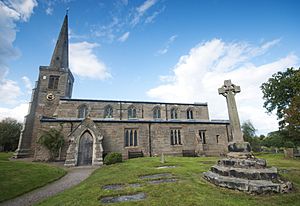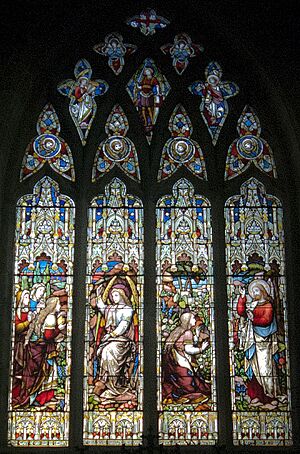Church of St Michael and All Angels, Hamstall Ridware facts for kids
Quick facts for kids Church of St Michael and All Angels |
|
|---|---|
 |
|
| 52°46′18″N 1°50′41″W / 52.771741°N 1.844824°W | |
| Location | Hamstall Ridware, Staffordshire |
| Country | England |
| Denomination | Anglican |
| History | |
| Founded | 1130—1150 |
| Architecture | |
| Functional status | Active |
| Heritage designation | Grade I |
| Architectural type | Church |
| Style | Norman |
| Specifications | |
| Number of spires | 1 |
| Administration | |
| Parish | Lichfield |
| Diocese | Lichfield |
| Province | Canterbury |
The Church of St Michael and All Angels is a very old and important church. It is located in the small village of Hamstall Ridware, in Staffordshire, England. This church is so special that it is listed as a Grade I listed building. This means it is one of the most important historic buildings in the country.
The church is in a quiet spot, a bit away from the village. You reach it by walking about 250 meters (820 feet) through fields. It sits on a gentle hill, about 160 meters (525 feet) west of the River Blithe. The church was first built a very long time ago, between 1130 and 1150. However, most of what you see today was built later, in the 1300s and 1400s. It is made from smooth, cut sandstone blocks.
Contents
The Church's Long History
How the Church Was First Built
The Church of St Michael and All Angels was first built around 1130 to 1150. It was made in the Norman style, which was popular back then. Originally, the church had only a main hall, called the nave, and a short area for the altar, called the chancel. Today, only small parts of the original west wall remain. If you look closely, you can still see some Norman stone on the outside, near the tower. Inside, there is a small Norman window above the arch leading to the belfry.
Changes Over the Centuries
During the 1300s and 1400s, the church was greatly expanded. In the 1300s, the church was made longer and its walls were built taller. The small original chancel was replaced with a much larger one. A small tower was added at the west end, and chapels were built on the north and south sides.
In the 1400s, even more changes happened. Aisles, which are side sections, were added on the north and south sides. The south aisle was made even longer to include a chapel and a room for the priest's clothes, called a vestry. A row of windows, called a clerestory, was built high up on the walls to let in more light. The small west tower was made taller, and a pointed roof, called a spire, was added. The wooden roof over the nave was also replaced in the late 1400s. Later, in the 1700s, the outer walls of the north chapel were rebuilt. In the 1800s, a gabled porch was added to the south entrance.
Special Features and Memorials
This old church has many interesting things to see inside:
- The Cotton Tomb is a very old monument from the time of King Henry VIII. The Cotton family were important lords of the area from 1375 to 1517.
- In the south aisle and outside in the churchyard, you can find memorials to the Stronginthearm family. They were a family of farmers who owned their own land.
- The south chapel screen is a decorative wooden barrier from the 1500s. It has a special type of arch called a Tudor arch.
- The north chapel is now used for the organ and as a changing room for the choir. It has its own screen from around 1520 to 1530.
- The choir seats from the 1500s originally came from Lichfield Cathedral, a much larger church nearby.
- The stone font (for baptisms) and the wooden pulpit (where sermons are given) were added in the 1800s.
- The side parts of the reredos (a screen behind the altar) have painted panels from the 1400s. These pictures show scenes from the Life of Christ.
- The church has four bells. They are hung two over two because there isn't much space in the bell tower.
Beautiful Stained Glass Windows
The oldest stained glass windows in the church are from the 1300s. You can find them in the south chapel, and they are dedicated to Saint Cecilia. There are also three windows from the early 1500s in the north aisle. These windows show nine of the twelve apostles. In one window, Saint John is shown holding a cup with a coiled snake inside it.
The west window on the south side shows the 'Baptism of our Lord' and was likely made in the 1900s. Another window in the south aisle remembers Reverend Humberton Skipwith, who passed away in 1911. He helped restore the church. The glass in the east window was made by a famous company called Ward and Hughes.
The Discovery of a Chalice and Paten
What Was Found?
In 1817, a local farmer named William Jaggard was digging a ditch. He was working on an old road near the Manor House when he found something amazing. He discovered a chalice and a paten. These are special objects used in church services. A chalice is a cup for wine, and a paten is a small plate for bread. These rare items were made of silver gilt (silver covered with a thin layer of gold) around 1350.
Why Were They Buried?
It is believed that these precious church items were buried during the Protestant Reformation. This was a time in history when many changes happened in the church, and some religious items were destroyed. People likely buried these objects to keep them safe from being lost or damaged.
Where Are They Now?
When William Jaggard found the chalice and paten, he gave them to the Lord of the Manor, Lord Leigh. Lord Leigh had them repaired. For a while, they were even shown at the famous Victoria and Albert Museum in London. Today, you can see these historic items on display at the Lichfield Heritage Centre.
See also
- Grade I listed churches in Staffordshire
- Listed buildings in Hamstall Ridware


